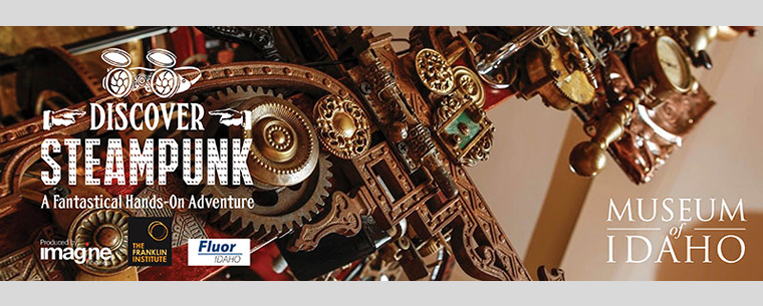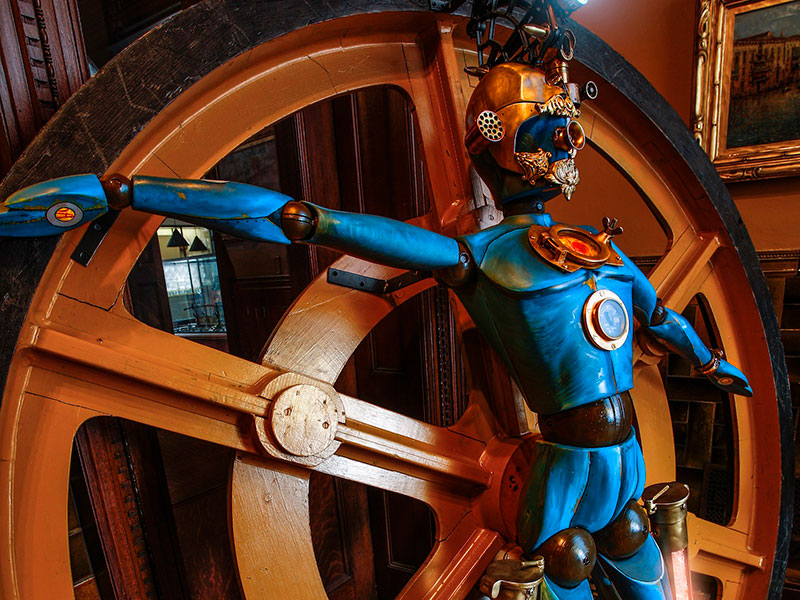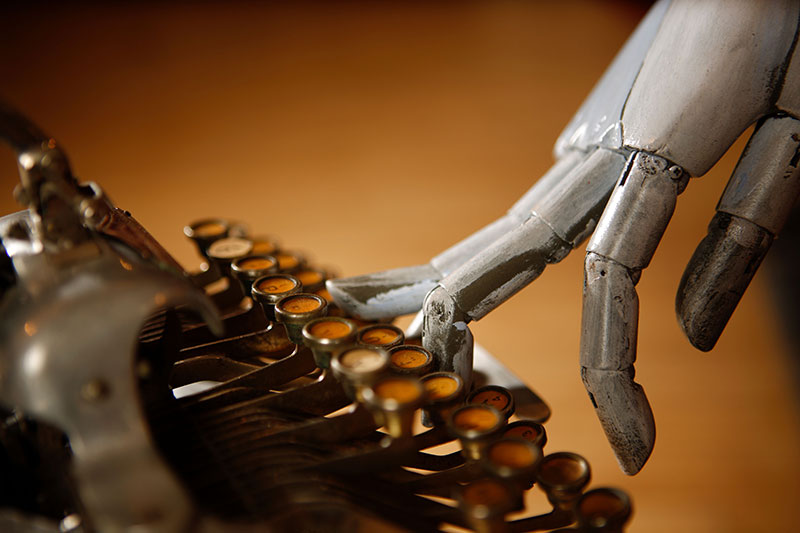
“Discover Steampunk” – New traveling exhibit
Your first task is to picture a steampunk exhibit at a science and history museum. Most out there couldn’t, of course, but if you’re reading this post, you probably can. Remove your mechanical cyborg arm and pat yourself on the back and get ready to “Discover Steampunk”.
So we know what it looks like. Now, here’s a harder one: what’s in the exhibit? What’s the educational substance? How does it connect the visitor to humanity, the world, and the past?
These are the questions one museum hopes to answer in its upcoming exhibit Discover Steampunk: A Fantastical Hands-On Adventure. The brand new, immersive exhibit, designed by Bruce Rosenbaum and Imagine Exhibitions, has its world premiere on May 11 at the Museum of Idaho in downtown Idaho Falls, just down the road from Yellowstone and Grand Teton National Parks. This rugged part of the country isn’t your traditional hotbed of steampunk activity, but the museum believes steampunk is the perfect medium to draw its visitors into a grand learning experience encompassing each of the disciplines of the appropriate new acronym STEAM: science, technology, engineering, art, and math.
Rod Hansen, the museum’s Director of Exhibitions, explains further. “The exhibit invites visitors to learn about the important union of science, art, technology and history through the stories of great 19th-century visionaries who dreamed of a better future.” OK. So who are these visionaries on tap to represent such a broad and varied movement? There are seven, each with a museum gallery devoted to their lives, ideas, and related technology. Three are pioneers of science fiction: Mary Shelley, Jules Verne, and H.G. Wells. Joining them are four seminal Victorian-era inventors: Isaac Singer, who developed the sewing machine; Thomas Blanchard, who worked on automation and the first automobiles; George Eastman, who helped popularize photography; and Jan Matzeliger, the son of a Surinamese slave, whose inventions made decent footwear accessible to the masses.
Each of the galleries has as its centerpiece a “humachine” – an intricate sculpture created by Rosenbaum that fuses the body of the visionary with some technology they envisioned. The humachine representing Singer, for instance, is known as “The Time Stitcher.” Each gallery also features original, interactive machines (more than 20 in all) that help visitors explore the scientific and societal principles surrounding the tech, including electricity, automation, photography, and more. For instance, Wells’s gallery contains an interactive telephone switchboard that teaches about the functioning of the internet, or “world brain,” as he called the idea. Verne’s gallery features an old-fashioned diving helmet outfitted with VR, so visitors can explore leagues under the sea alongside him. Shelley’s gallery contains hands-on electrical experiments and discusses the ethics of creating life artificially.
The underlying idea is for visitors to come away with new ideas about creative problem-solving and innovation – how it sparks, how it contends with society, and how it moves society forward. The museum hopes to instill the notion that many of today’s most prevalent technological advances aren’t as new as they seem – that we all owe a great deal to dreamers and tinkerers in the past, and that our great-grandchildren are relying on us to dream and tinker now.
The museum expects the exhibit will wow visitors. The hard part will convincing them to come in the first place. After all, even if Idaho Falls in 2018 becomes somewhat of a pilgrimage site for die-hard steampunk fans around the country, what of the museum regulars? What of those who have never heard the word and would naturally distrust a “punk”? Museum officials expect 50 to 60 thousand will visit the exhibit during its eight-month stint, but longtime docents have expressed concern. They remember a beautiful, immersive exhibit years ago about the first expeditions to the South Pole. They called it one of the best exhibits the museum ever had, but nobody came, because the exhibit’s title was vague, and made no mention of the South Pole or Antarctica. People had no frame of reference to know whether they would enjoy it.
To avoid a repeat with Discover Steampunk, museum officials have spent months educating Idahoans about the movement, and seeding found-metal sculptures in different places to spark conversation. Initially, the museum’s explanatory efforts focused more on using popular movies to show the public where they’d encountered steampunk before. (A trick most readers likely resort to on occasion.) Lately, though, the focus has been on the more familiar faces – Verne, Wells, etc. – and the interactive machines themselves. That way, young and old, comics shop owner and rancher know what they’re getting into.
John Zaller, one of the exhibit’s creators at Imagine Exhibitions, says it should have broad appeal. “The optimistic nature of steampunk . . . seeks to understand the inner workings of things to make them better,” he said. “That’s the same principle by which the scientific method operates and why steampunk is the perfect combination of science and art.”
In conjunction with the exhibit, the museum is holding several themed events, including a VIP grand opening event and a Victorian dance in May, a steampunk street party and Maker Faire in September, and a large steampunk ball as an end-of-the-year fundraiser. At each event, the museum is encouraging steampunk dress, which has driven museum regulars to frantic Google searches and shopping trips. The museum is working with a local mall to highlight where steampunk-friendly garments and footwear can be found within.
“People in the community are getting excited,” said Karen Baker, the museum’s executive director.
After about eight months on display, Discover Steampunk will don its goggles and take flight on a multi-year tour of additional museums throughout the world. What remains to be seen is whether Idahoans, who will then be among the world’s most educated on the subject of steampunk and innovation, will take what they’ve learned and keep it going.




